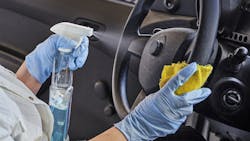The importance of cleaning and disinfecting your trucks
COVID-19 and the high cost of business insurance have made it more important than ever for fleets to be aware of protecting the health and safety of their employees, according to Troy Guidry, senior risk control consultant for Gallagher, a collection of insurance and risk management consultants.
Speaking at a recent NationaLease meeting, the consultants reminded attendees of the importance of adopting best practices for keeping trucks clean and sanitary. They said that it is important to identify zones or sections of trucks that need to be cleaned and to identify and give extra attention to high-touch surfaces. Proactive disinfection processes should be developed based on the type of trucks and the area of the vehicle being sanitized.
- High-touch areas include the steering wheel, turn signal, door handle, gear shift, seat adjustment controls, and seat belts.
- For hard, nonporous surfaces like hard seats, arm rests, door handles, seat belt buckles, windows, grab handles, etc., it is a good practice to clean them with detergent or soap and water before applying disinfectant. Use EPA List N disinfection products on hard nonporous surfaces.
- For soft or porous surfaces such as fabric on seats, begin by removing any visible contamination. Use a HEPA vacuum and disinfect with EPA List N products approved for porous surfaces.
- Don't overlook frequently touched electronic surfaces such as tablets or touchscreens. Remove visible dirt and then use alcohol-based wipes or sprays that have at least 70% alcohol.
- When disinfecting trucks, make sure there is adequate ventilation if you are using a chemical disinfectant. Make sure the vehicle’s doors and windows are open. Review the Safety Data Sheets for all chemicals used in the cleaning process and use proper PPE including nitrile disposable gloves and eye protection.
- When it comes to the actual cleaning process, start with the area furthest from the door and work your way to the door. Clean from the center console out toward each door. Start at the highest point of the vehicle and work your way down to the lowest point.
- Once the vehicle has been cleaned, clean and disinfect any cleaning buckets or vacuums that were used. Dispose of any debris in sealable plastic trash bags.
- Finally, remove and dispose of gloves, clean any eye protection that was used, and make sure you wash your hands.
With the proliferation of COVID variants and the coming flu season, it is worth taking extra time to make sure vehicles are cleaned and sanitized to keep employees safe and healthy.
This article originally appeared on FleetOwner.com.
About the Author
Jane Clark
vice president, member services for NationaLease
Jane Clark is vice president, member services for NationaLease. In this position, she is focused on managing the member services operation, as well as working to strengthen member relationships, reduce member costs, and improve collaboration within the NationaLease supporting groups. Prior to joining NationaLease, Jane served as area vice president for Randstad, one of the nation’s largest recruitment agencies, and before that, she served in management posts with QPS Companies, Pro Staff, and Manpower, Inc.
